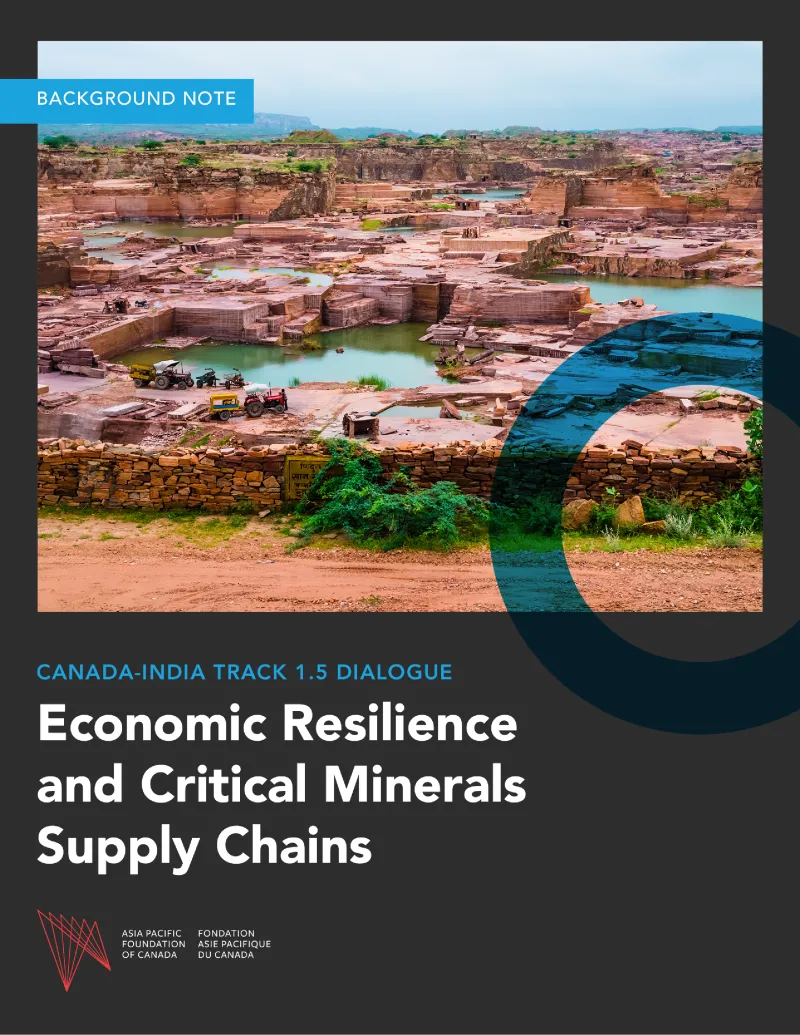A Background Note in support of APF Canada's November 25, 2025, India-Canada Track 1.5 Dialogue on Critical Minerals and Supply Chain Resilience in New Delhi, India.
The G7 Summit, hosted by Canada in June 2025, marked a pivotal moment in the renewal of Canada–India relations after nearly two years of diplomatic strain. The meeting between Prime Minister Mark Carney and Prime Minister Narendra Modi at this summit unlocked bilateral re-engagement on shared strategic priorities, such as trade, technology, and resource security. One of the key outcomes was India’s endorsement of G7 Canada’s Critical Minerals Action Plan — a development reflecting the two countries’ growing alignment on clean-energy transitions and supply-chain resilience amid intensifying global competition.
Building on this momentum, Canada’s Minister of Foreign Affairs, Anita Anand, visited India between October 12–14, 2025. Among the key discussions during the visit were advancing clean and secure energy co-operation, including how Canada’s critical mineral reserves, mining expertise, and technology could help meet India’s energy security needs. Both sides also welcomed continued engagement on uranium supply and agreed to hold the first Canada–India Critical Minerals Annual Dialogue on the margins of the Prospectors and Developers Association Conference (PDAC) in Toronto in March 2026. In a subsequent meeting on November 13, 2025, in New Delhi, Canada’s Minister of International Trade, Maninder Sidhu, underscored the importance of strengthening collaboration and investment in the critical minerals sector.
Recent budget allocations in both Canada and India underscore each country’s growing prioritization of the critical minerals sector. Since announcing its Critical Minerals Strategy in December 2022, Canada has committed about C$4 billion to support critical mineral production, including about C$2.42 billion in new funding in this month’s federal budget to strengthen domestic capacity and supply-chain resilience. The centrepiece of this allocation is a C$2-billion Critical Minerals Sovereign Fund to facilitate investment in mining projects, with a key objective of building domestic refining and processing capacity — an area where strategic foreign investment and partnerships will also be essential.
Complementing these budgetary measures, Canada is also fast-tracking strategic mining projects through the Major Projects Office — a federal co-ordination unit launched on August 29, 2025, by Carney to streamline regulatory approvals and get major projects built faster. On November 14, 2025, Ottawa added three major critical-mineral projects to its list of “nation-building projects” — the Sisson Mine (tungsten–molybdenum), Crawford Nickel, and Nouveau Monde Graphite Phase 2 — located across the provinces of New Brunswick, Ontario, and Québec. The move is intended to accelerate permits, attract private investment, and expand Canada’s upstream capacity in minerals essential for clean-energy and defence supply chains.
In India, the government removed import duties on about 40 critical minerals in the 2024 and 2025 budgets to expand much-needed mineral imports. To strengthen domestic capacity, it also launched the National Critical Mineral Mission to support all stages of the value chain — from exploration and mining to processing and recycling — with a budget allocation of about C$2.57 billion over seven years, until 2032. In July 2023, the Ministry of Mines released a list of 30 critical minerals — including lithium, cobalt, nickel, graphite, and rare earth elements — marking a major step in defining India’s mineral priorities and guiding investment and exploration. Several regulatory reforms have been introduced to expand the exploration and mining of critical minerals, encourage greater private sector participation, and increase the involvement of state-level governments across the value chain.
These policy measures come amid a sharp rise in India’s critical mineral demand. Imports more than doubled in recent years — climbing from C$3.03 billion in 2020–21 to C$8.01 billion in 2023–24 — driven by a boom in EVs, renewable energy, and semiconductor manufacturing. Canada currently supplies only a small share of its total critical mineral exports to India — around two per cent in 2023 and 2024 — while most of India’s essential inputs — lithium, cobalt, nickel, and rare earth elements — are sourced predominantly from China. With domestic reserves insufficient to meet projected needs, India is complementing homegrown reforms with a growing network of international partnerships to source, process, finance, and de-risk critical-mineral supply chains.
As federal initiatives gain momentum on both sides, the next phase of Canada–India collaboration will also increasingly hinge on subnational engagement. In both countries, provinces and states hold jurisdiction over natural resources and anchor key critical mineral projects, processing facilities, and investment ecosystems. Understanding these subnational strengths and opportunities will be essential to identifying concrete partnership opportunities across the value chain.
Canada’s Subnational Critical Minerals Landscape
Nine subnational governments in Canada — Alberta, British Columbia, Saskatchewan, Newfoundland and Labrador, Manitoba, the Northwest Territories, Ontario, Nova Scotia, and Québec — have introduced their own critical mineral strategies. The strategies of the top five critical-mineral-producing provinces are outlined below, along with their current engagement with India and emerging opportunities.
-
Québec
The province of Québec was the first to introduce a Plan for the Development of Critical and Strategic Minerals (2020–25), setting a five-year framework for sectoral growth. Supported by targeted policy incentives, Québec accounted for around 38 per cent of Canada’s total critical minerals production in 2022, the highest share of any province. It also hosts one of the country’s most diverse critical-mineral endowments, including lithium, nickel, cobalt, graphite, and rare earth elements, among others, essential for the EV battery and clean-technology ecosystem.
Given weakening demand in the U.S. electric vehicle market — partly driven by the rollback of EV incentives making EVs relatively more expensive for consumers — Québec’s critical minerals and battery ecosystem is increasingly looking to diversify toward fast-growing markets. India, where EV sales and battery-mineral demand are rising sharply, represents a natural partner, although Indian investments in Québec’s critical-mineral sector remain historically absent. Québec-based pension fund Caisse de dépôt et placement du Québec (CDPQ), however, has invested over C$10 billion as of December 31, 2024, in India across renewable energy, infrastructure, real estate, and private equity — with no investments in critical-mineral projects.
There is also significant untapped potential in the trade of critical and strategic minerals. Québec’s exports to India remain limited in critical minerals, comprising less than one per cent in ferro-niobium and about seven per cent in aluminium and copper scrap, with the U.S. accounting for the largest share of these exports.
-
Ontario
Ontario introduced its Critical Minerals Strategy (2022–2027) in March 2022 to strengthen geoscience, expand domestic processing, modernize regulations, and build local supply chains. The province hosts rich deposits of nickel, lithium, cobalt, platinum, and graphite, along with over 130 early-stage and 16 advanced-stage exploration projects. With existing smelters and refineries for nickel, copper, cobalt, uranium, and platinum-group elements, Ontario plays a key role in North America’s clean-energy and EV-battery value chains. To further expand its processing capacity, the Ontario government invested C$500 million in May 2025 in a new Critical Minerals Processing Fund to increase domestic processing and reduce exposure to external market risks such as U.S. tariffs and broader economic uncertainty.
The province is also advancing battery recycling and mineral recovery to promote circularity, particularly for nickel, lithium, cobalt, manganese, and graphite. In trade, Ontario’s exports to India in 2024 are largely in aluminium and copper metal scrap, making up around nine per cent of total exports and leaving scope to expand in refined critical minerals. While Ontario-based pension funds such as the Ontario Teachers’ Pension Plan (OTPP), the Canada Pension Plan Investments (CPPI), and investment firms such as Brookfield Corporation are active investors in India’s infrastructure, financial services, telecom and real estate sectors, they too have not yet officially entered India’s mining or critical-minerals sector — a gap that could narrow through provincial or federal trade and investment facilitation frameworks.
-
Saskatchewan
Saskatchewan launched its Critical Minerals Strategy in March 2023 to drive growth and attract investment in the sector. Following Québec, the province accounted for 31 per cent of Canada’s critical-mineral production in 2022, supported by advanced projects and active mines for uranium, potash, and helium. Saskatchewan has also been an active partner for India, advancing co-operation in fertilizers, agri-food, and critical minerals.
In September 2022, Indian fertilizer companies signed a long-term supply MoU with Canpotex, the Saskatchewan-based potash exporter, for the supply of up to 1.5 million tonnes annually. More recently, in March 2025, the University of Saskatchewan and India’s CSIR–Institute of Minerals and Materials Technology signed a Joint Declaration of Intent to collaborate on critical minerals research. Potash, an essential critical mineral used in agriculture as a fertilizer, made up about 63 per cent of Saskatchewan’s critical-mineral exports to India in 2023.
As a path forward in deepening collaboration, the renewal of the Canada–India uranium supply agreement has been pending since 2020 — a move that could benefit stakeholders in both Saskatchewan and India. There are also minimal helium exports from Saskatchewan, despite the element’s importance in India’s growing semiconductors, aerospace, and nuclear technology sectors. Additionally, two-way investment flows remain limited, underscoring the potential to expand co-operation across the mining and clean-energy value chains.
-
Newfoundland and Labrador
Newfoundland and Labrador launched its Critical Mineral Plan in November 2023, with C$4.3 million investments in critical mineral geoscience using innovative techniques, including artificial intelligence and remote sensing technologies, as well as funding for several critical mineral exploration projects. The province made up 7.18 per cent of critical mineral production in Canada. It is home to 25 critical minerals and is a major producer of nickel, copper, zinc, and cobalt, with emerging potential in rare earth elements. While Newfoundland and Labrador exports critical minerals globally — including larger shipments to China within Asia — exports to India remain minimal, mainly nickel, small amounts of metal scrap, and minor lithium-ion battery shipments. India is not yet a significant destination for the province’s critical mineral exports, underscoring substantial untapped potential for trade and investment as India’s demand for these minerals continues to grow. Close collaboration between the province and Indian critical-mineral sector counterparts could help unlock these opportunities.
-
British Columbia
British Columbia launched Phase 1 of its Critical Minerals Strategy in January 2024, outlining 11 priority actions to develop the province’s critical minerals sector while upholding high environmental, social, and labour standards. The province hosts advanced projects, smelters, and mines producing niobium, aluminium, zinc, bismuth, indium, and germanium, and is Canada’s largest producer of copper and only producer of molybdenum, which is essential in advanced manufacturing. With over 1,100 mining companies operating globally and 944 publicly listed firms headquartered in B.C., the province possesses a deep pool of mining expertise and professional capacity.
Despite this strong base, B.C.–India engagement in the mining and critical minerals sector remains limited. Investments and partnerships in technology exchange or mining expertise have been negligible on both sides. In trade, while copper ores and concentrates form a key export, B.C.’s shipments to India remain minimal in value-added or refined critical minerals, with no major exports of lithium, nickel, or cobalt. This underscores significant potential to expand co-operation in downstream processing, joint ventures, R&D collaboration, and circular-economy partnerships.
Other provinces and territories — including Alberta, Manitoba, the Northwest Territories, and Yukon — also hold significant potential. The Northwest Territories has advanced projects in rare earth elements, cobalt, bismuth, and copper, while Manitoba hosts deposits of cobalt, copper, lithium, nickel, and platinum-group metals. Alberta, though at an earlier stage, shows strong geological potential in lithium, vanadium, rare earth elements, uranium, and helium, while Yukon has advanced zinc, copper, and tungsten projects.
As Canada’s provincial landscape on critical minerals continues to evolve, bilateral partnerships need to be powered through closer subnational engagement to capitalize on emerging opportunities in critical-mineral sourcing, processing, investment, and technology collaboration.
Subnational Dynamics in India’s Critical Minerals Landscape
Much like in Canada, India’s critical mineral ambitions are increasingly shaped by state-level activity. With the introduction of Exploration Licences (ELs) in 2023, aimed at attracting foreign and private players to undertake reconnaissance and prospecting operations for 29 critical and deep-seated minerals — such as potash, rare earth elements (REEs), lithium, and cobalt — states are playing a major role in facilitating auctions and driving exploration, mining, and investment partnerships across the value chain. Backed by 1,200 exploration projects scheduled for 2024–25 to 2030–31, states such as Karnataka, Rajasthan, Maharashtra, Madhya Pradesh, and Chhattisgarh have emerged as early leaders, together accounting for the first round of EL block auctions. These states are rich in copper, lithium, nickel, REEs, potash, and base metals, positioning them as India’s principal exploration and upstream development zones.
Beyond exploration, several states are advancing along the value chain. Odisha combines strong mineral reserves with established refining and metals infrastructure; Rajasthan and Madhya Pradesh are piloting beneficiation and processing initiatives; and Karnataka is leveraging its innovation ecosystem for green-mining and recycling research. Simultaneously, industrial states such as Gujarat, Maharashtra, and Tamil Nadu are becoming downstream hubs, integrating mineral supply with clean-energy manufacturing, EVs, and battery ecosystems. This geographic diversification links resource availability with industrial capacity.
For partners like Canada, this evolving subnational landscape underscores the importance of region-specific engagement. Exploration-intensive states — such as Rajasthan and Karnataka — offer opportunities for mining technology transfer, geological collaboration, and ESG-aligned exploration, while industrialized states — such as Gujarat and Maharashtra — present avenues for joint ventures in processing, advanced materials, and circular-economy innovation. Tailored partnerships that account for state-level and provincial needs and capabilities can thus further deepen co-operation.
Charting the Path Forward
As both Canada and India accelerate their clean-energy transitions, critical minerals co-operation can evolve from dialogue to tangible partnerships. Québec’s expertise in lithium processing could align with Karnataka and Gujarat’s manufacturing ecosystems, while Saskatchewan’s potash and uranium sectors could collaborate with Rajasthan and Odisha on fertilizer and refining technologies. Yet, despite clear complementarities, there are no publicly recorded bilateral investments in this sector, and exports remain limited to a few minerals, underscoring the need to enhance two-way trade, investment, and technology collaboration. India is a major Asian power with the capability and new policy frameworks to invest in overseas exploration, development, mining, and processing of strategic minerals to secure its domestic supply — presenting a timely opportunity for Canada to position itself as a preferred partner.
A forward-looking roadmap should prioritize strategic alignment, subnational linkages, and joint investment mechanisms to strengthen supply-chain resilience and sustainability. The proposed Canada–India Critical Minerals Annual Dialogue, beginning at PDAC 2026, can serve as a key platform for policy co-ordination, standard-setting, and investment facilitation. Establishing a Joint Working Group on Critical Minerals under this framework would help align both countries’ strategies — focusing on responsible sourcing, traceability, and circular-economy integration.
Moving forward, advancing a trade and investment agreement between Canada and India would help build investor confidence and signal long-term policy stability. Joint efforts on skills and traceability, combined with collaboration through multilateral platforms such as the Minerals Security Partnership, Indo-Pacific Economic Framework, and forums such as the G7 (where India participates as an invited partner) and the G20, can further align sustainability goals. By establishing institutional mechanisms with targeted subnational partnerships, Canada and India can anchor a resilient, responsible, and mutually beneficial critical minerals ecosystem that supports both countries’ energy and economic security.
• Edited by Suvolaxmi Dutta Choudhury, Program Manager, South Asia, Vina Najibulla, Vice-President Research & Strategy, and Ted Fraser, Senior Editor, APF Canada








